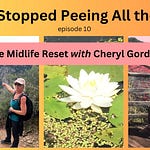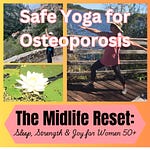You’ve seen the x-ray. It’s bone on bone. The pain’s been building for years and now surgery feels like the only option.
I get it. I’ve walked this path with so many clients—and here’s what I want you to know:
You don’t have to wait until after surgery to start feeling better.
Today we’re talking about prehabilitation—what it is, why it matters, and how it can help you recover faster, reduce pain, and feel stronger before you ever enter the operating room
Hi, I’m Cheryl Gordon and this is episode #15 of the Midlife Reset podcast. I help midlife women sleep better, lose weight and feel stronger using the tools of yoga and mindfulness.
Today I would like to share a new branch of therapy called Prehabilitation. You’ve all heard how important rehab is… well you can start making a positive difference prior to surgery!
Prehabilitation is a personalized exercise, education, and lifestyle program undertaken before surgery to optimize recovery. Often abbreviated as "prehab", it prepares you physically and mentally for the demands of surgery and rehabilitation. It focuses on improving strength, flexibility, cardiovascular fitness, nutrition, and mindset.
Research shows patients who do prehab:
Recover faster
Use less pain medication post-surgery
Spend less time in hospital
Regain mobility more quickly
Think of it like training for a marathon—you wouldn’t show up without preparing!
Here’s how it works.
Strengthen muscles around the joint - the reason you are facing surgery is because there has been some imbalance in how your muscles are performing. It’s been building for a long time. Some muscles are a little tight, pulling on the bone so it accidentally bumps against tissue it shouldn’t be touching. Other muscles that were designed to work in the opposite direction are probably sleepy. Not pulling their weight. The result is the joint is out of balance. If you, even now the joint has been damaged, start to balance out the function of the muscles, it will bring a little relief. It also prepares you for when you get new hardware. Your muscles will be in a better position to adjust to new movement patterns.
Improve balance and mobility - post surgery, falls can be catastrophic. Working with yoga poses can give you proprioceptive awareness of how you are walking and moving. Being more mindful of your body reduces accidents and clumsiness.
Reduce pain and inflammation - movement creates circulation. Fresh fluids flushing through the joint sweep away some of the inflammatory compounds that are causing the swelling, heat and pain. Yoga tools also help calm the mind. Paper cuts always hurt more at the office due to the mindset. It’s a stressful place! So pain signals are received differently in less stressful environments. Regular practice of meditation or breathing techniques can reduce one’s experience of joint pain.
Manage weight if needed - exercise itself doesn’t result in weight loss. That’s a whole other podcast (ep #2 is one to check out) but yoga will help manage weight in so many ways (check out ep #4 for more info on stress and weight gain). And you know your doctor has pointed out that losing one pound of body weight takes almost 10 pounds of weight off your knee joint.
Build confidence and reduce anxiety - wait times are long prior to surgery and you hear all the horror stories, right? Yoga gives you a positive place to hang out for a while each day. You know you’re building something better for yourself that will pay dividends in the long run.
How does one do “prehab”? In my “Hip and Knee Release and Strengthen” series, I’ll show you step by step. More on that later. For general joint freeing, this is a free video series that will guide you step by step.
Elements to look for in a prehab program are:
a Program tailored to your ability - the joint in question is angry and painful. Any movements need to take that into account. We don’t want to create more pain. Using chairs, yoga straps and other props can make positions safer and more accessible.
Relieve pain as much as possible first. This means nurturing the nervous system with calming practices like restorative yoga and breathing BEFORE exercising the body.
Mobilize the joint without weight bearing at first. Just lubricate and flush it with simple range of motion movements. This is done really well in my Joint Freeing series. I’ll put a link to these videos in the show notes. I’ve used this practice with my clients for years and I practice some form of it myself every day. It’s really a miracle cure for stiffness and joint pain. Don’t worry… the most popular version of this is done mostly seated in a chair. You won’t have to get down on the floor.
Gradually build strength in the weaker muscles. Typically, and every one is different, the rear kinetic chain is less responsive and that is what has been pulling the bones out of alignment. The muscles in question are the buttocks, backs of thighs and calves.
Practice weight bearing exercises with meticulous alignment. These are poses like the warrior series, lunges and chair. Expert instruction can help you recognize how to fire the big mover muscles such as the ones mentioned above as well as the quads. Coordinating the activation in a smooth order eases joint pain.
If the joint is ready for surgery, no stretching! I’ll cover the detailed reasons for this in an upcoming podcast, but for now, think of it this way. You have swelling, redness and pain. The connective tissue around the joint (think cartilage, tendons, ligaments, fascia, etc) are inflamed and scared. The last thing this part of your body needs is pulling on it. It’s got no stretch to give! In the Hip and Knee Release and Strengthen series, I show many examples of isometric muscle work. This strengthens the muscles but doesn’t cause any pulling. Can be really helpful for calming pain.
Light exercise such as short walks or bicycle rides may be accessible and can be beneficial. Mostly due to the reduction in stress hormones that results from pleasant activity that you enjoy.
I think the biggest part of a prehab program should be pain and stress management. It is so vital to practice breathing exercises, mindfulness and self compassion just as vigorously as you focus on the exercises. This is preparing your mind for surgery. And your mind is your most powerful recovery tool.
Looking at nutrition to support healing is also essential. It’s so easy to get busy and say “all things in moderation” while we’re knee deep in birthday cake or Doritos. I speak from experience here. In midlife, we just can’t ignore that we are more insulin resistant, more prone to inflammation and decades of stressful lives have taken their toll. (check out ep #3) To address this hormonal challenge, fibre is your friend. Are you getting enough protein? Experts are recommending about 30 gr per meal. Protein is a major building block for connective tissue and muscle. My colleague, Sharlene Styles, has some great nutritional resources on her website so I’ll link to that in the show notes.
What are the best exercises for hip and knee prehab? I’ll guide you step by step in the Hip and Knee Release and Strengthen series. But if you want to get started on your own, I would recommend bridge pose. You can do this in bed if getting down on the floor is tough. I also recommend a yoga block between the knees to stabilize the joints further.
As I mentioned earlier, isometric movement is very effective and doesn’t amp up the pain because the joint isn’t moving. Seated in a chair, with the yoga strap around the thighs, you can practice hip abduction. There are so many other applications of this technique. Leg raises while seated in a chair strengthens quads and heel slides work the hamstrings.
Make sure the movement isn’t making the pain worse. It’s recommended to get the advice of a physio or yoga therapist.
Anyone scheduled for hip or knee replacement will benefit from prehab. And older adults, those with chronic pain, arthritis or obesity also should consider taking charge. When you are going to the doctor and being poked and prodded all over the place, it can be demoralizing. Taking charge of your prehab can at least give you that positive space each day to hang out and visualize how amazing you’ll feel when you’re stronger.
I can’t tell you the number of clients I’ve had over the years who have reported back that their surgeons were amazed by the speed or quality of their recovery. Many clients have even shared that while they were actually waiting to get called in the operating room, they practiced breathing and relaxation techniques. It helped them stay calm in those scary times. Stressed out systems do not have the same amount of energy for healing. And there have been dozens of clients who either put off surgery or cancelled it all together.
Get started on your prehab Asap. The yoga therapy approach is to do small amounts of prehab but frequently. It’s not about exhausting the muscles. No hour long fitness marches. My program suggests about 15 minutes at a time, easeful and relaxed, but repeat that several times per day. It’s the frequency, the repetition grooving new neural pathways that will guide smoother movement.
Prehab isn’t just physical—mental preparation matters too.
Learn relaxation techniques
Practice positive visualization of recovery
Build trust with your health care team
Helps reduce post-op depression and fear of movement
Prehab is Empowerment. Prehabilitation is an investment in your future mobility. It helps you take an active role in your healing. The stronger and more informed you are going in, the better you’ll come out.
Check out the Hip and Knee Release and Strengthen at home prehab course. The link is in the show notes. Start the Joint Freeing Series using a chair if necessary to lubricate those joints. And let me know how you’re doing.













Share this post